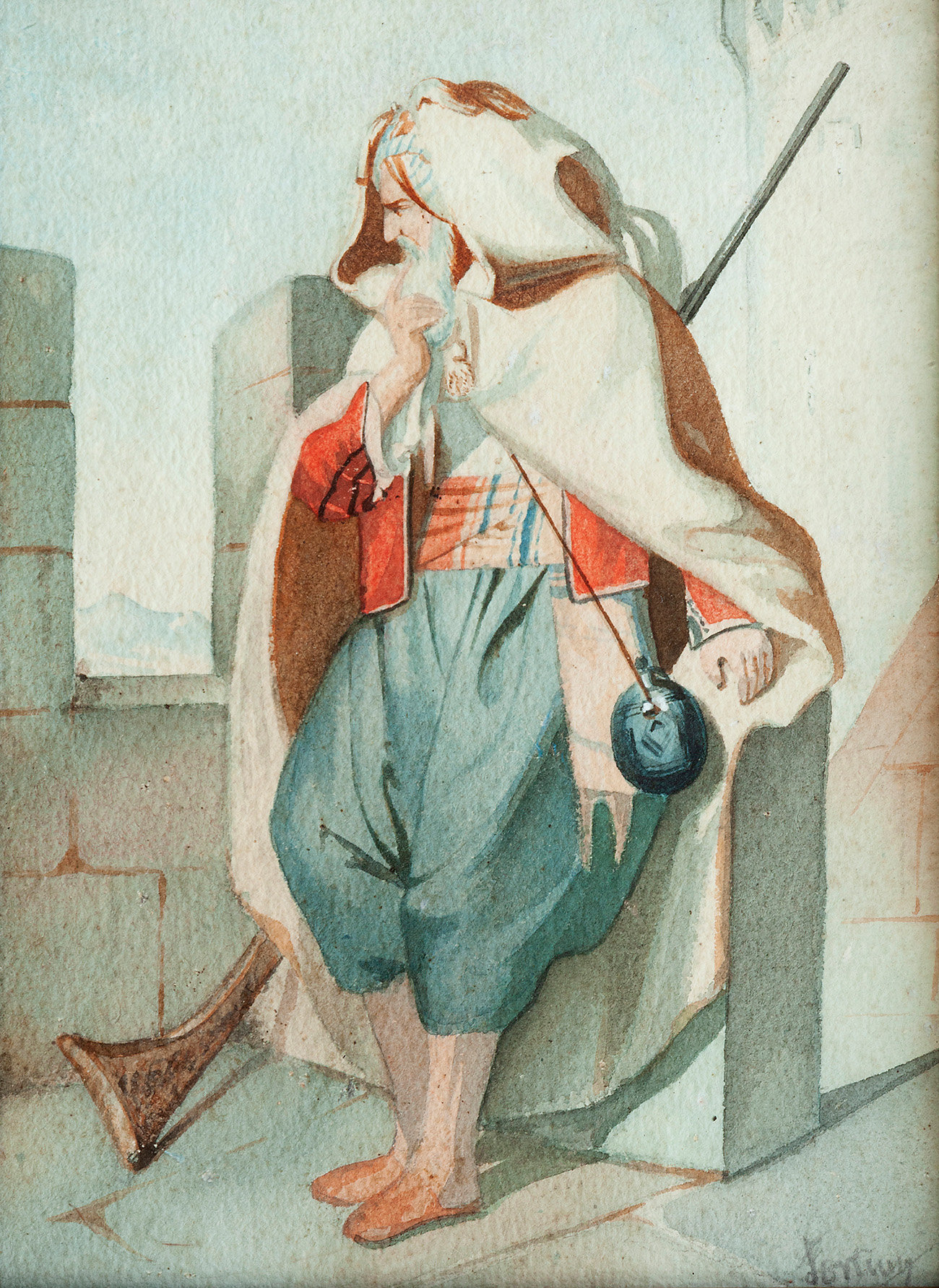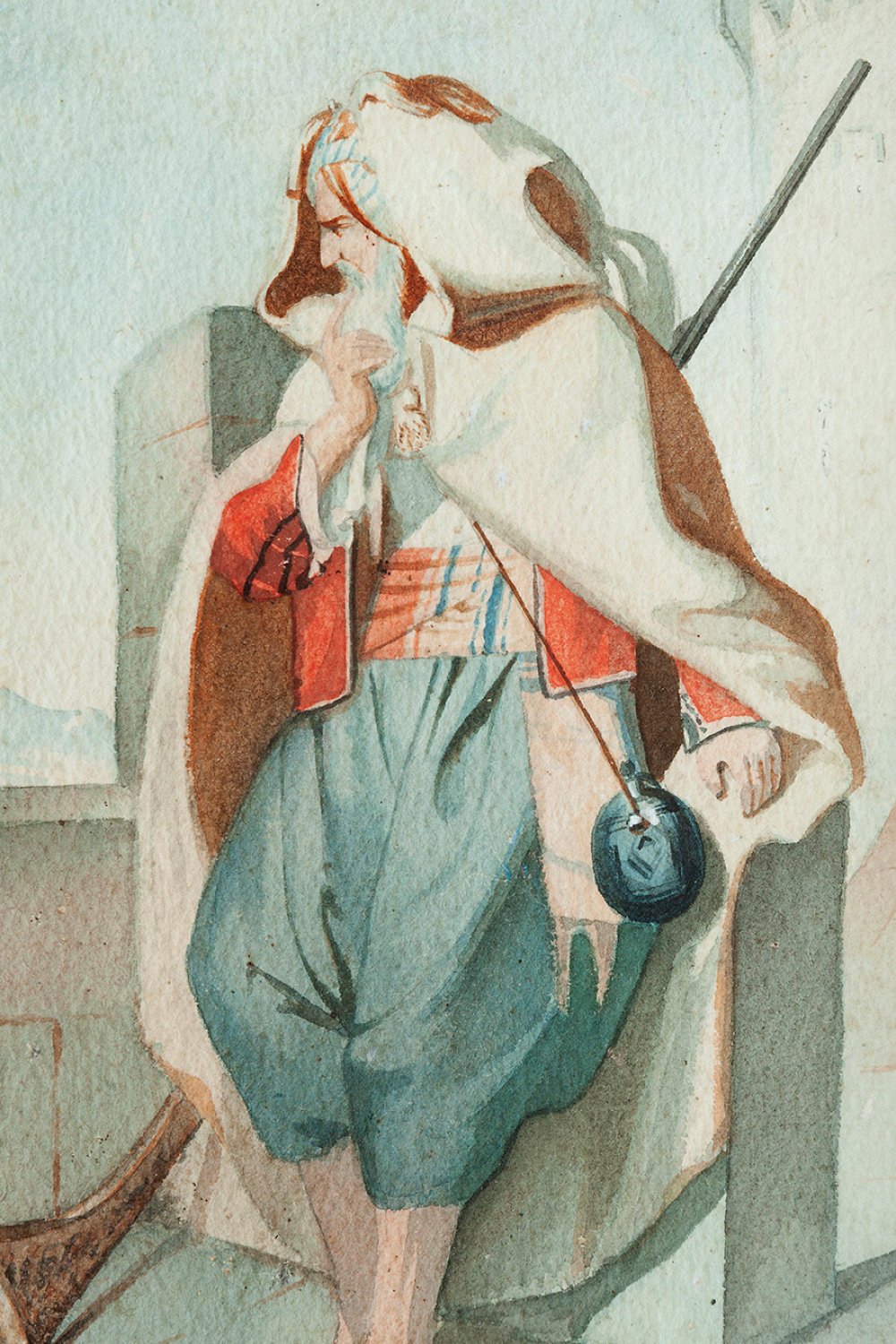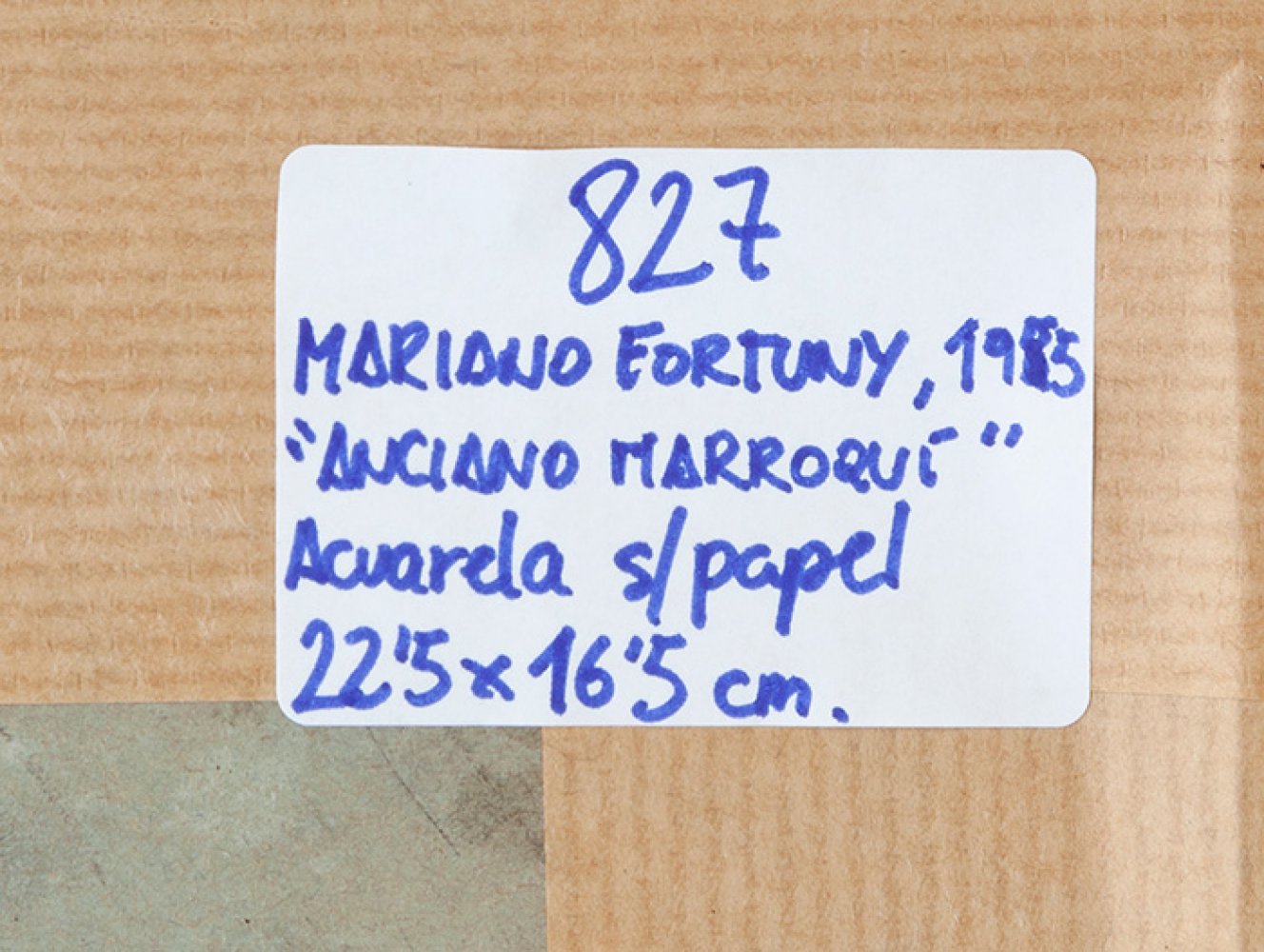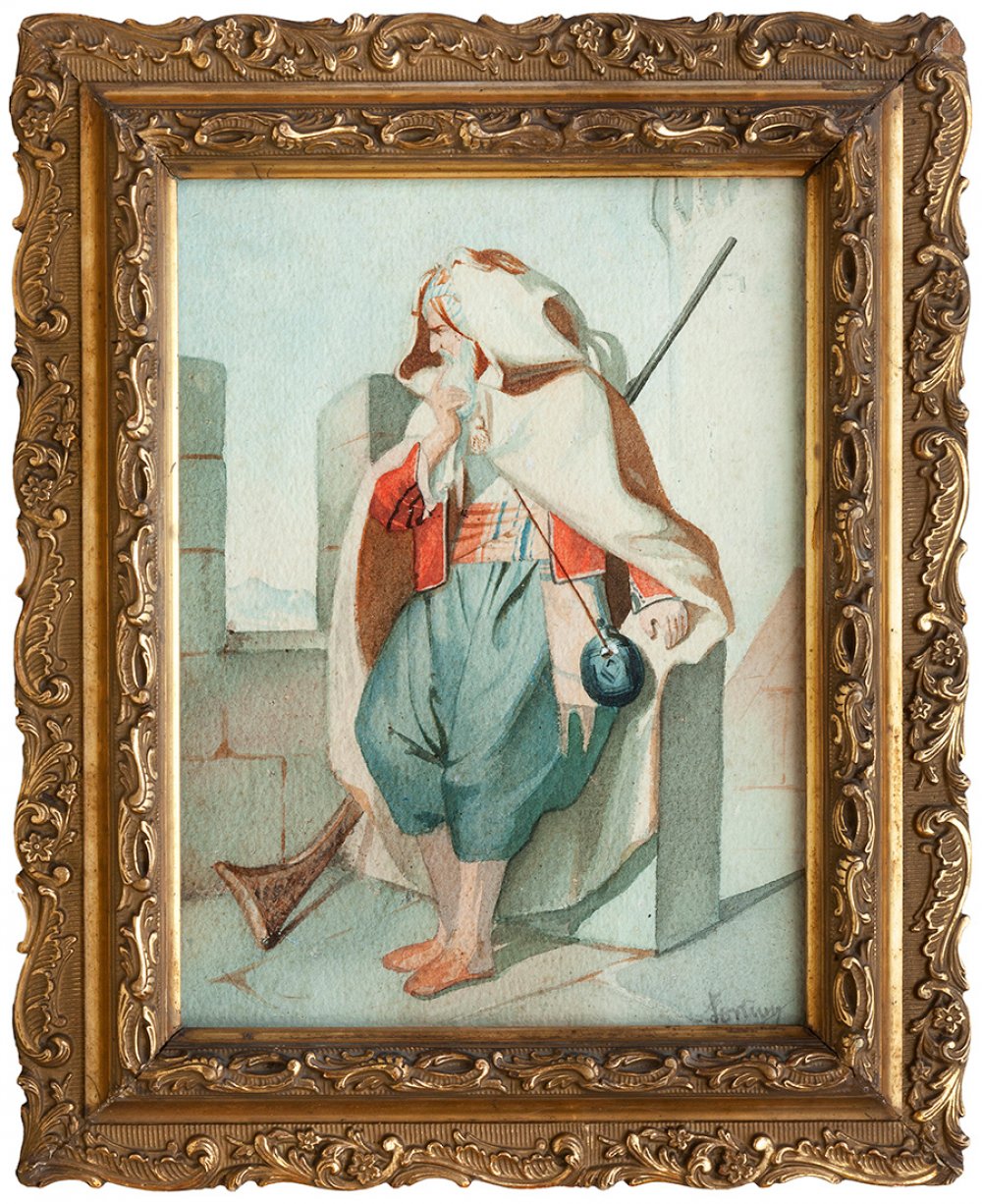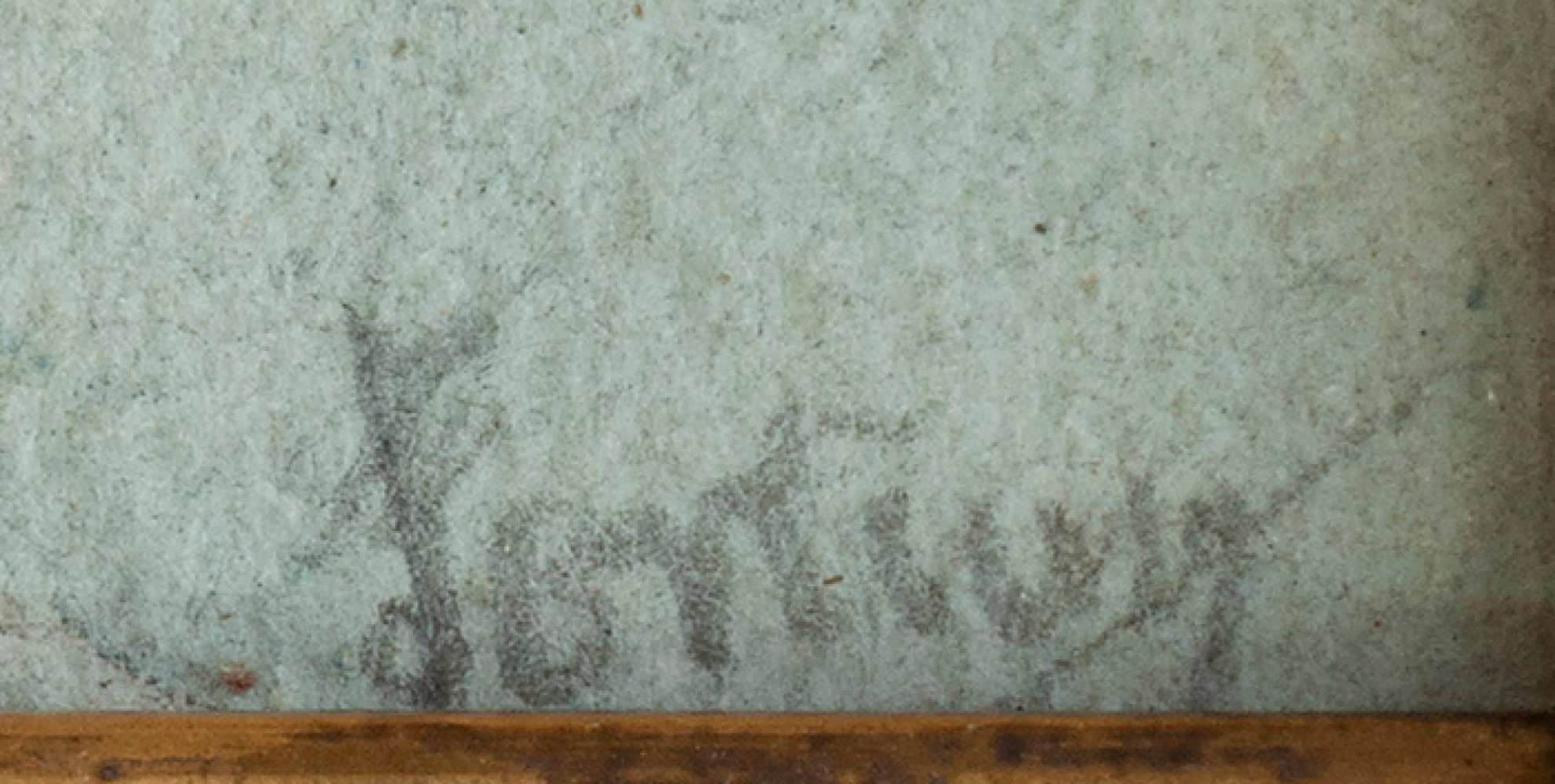5
MARIANO FORTUNY MARSAL (Reus, Tarragona, 1838 - Rome, 1874)."Moroccan Elder", ca.1855.Watercolour on
"Moroccan Elder", ca.1855.
Watercolour on paper.
Signed in the lower right corner.
Bibliography: exhibition catalogue "Fortuny", Barcelona, 1940, cat.507. /González, Carlos González López and Montserrat Marí Ayxelá, "Mariano Fortuny Marsal", ediciones Catalanas, Barcelona, 1989. Volume II, p.34.Provenance: Ramon Pons i Bas Collection, Jaime Pons Collection, Private Collection.
Measurements: 22 x 16 cm; 30 x 25 cm (frame).
This watercolour has been identified with the one in the catalogue (no. 507) of the Fortuny exhibition held in Barcelona in 1940. According to the description in the catalogue, as well as the medieval subject and the treatment still indebted to the Nazarene style, this watercolour can be dated to around 1855, when Fortuny was working in Claudio Lorenzale's workshop. It depicts an old Moroccan man in oriental attire (breeches, sash around his waist, turban and long hooded cloak revealing a container for gunpowder). The figure ties his white beard, restless and pensive, as he gazes out over the crenellated castle towards the horizon. Doctors González López and Marí Ayxelá argue that it could be an episode from the Cantar del Mío Cid (the capture of Valencia in 1094), comparing the watercolour with sketches of medieval themes that he had made in Lorenzale's workshop, whose subjects were set in the time of Ramón Berenguer III and his triumph over the Almoravids in Lérida and Tortosa. Stylistically, we can see the influence of the German idealist style which, under the influence of Lorenzale, prevailed at the School of Fine Arts in Barcelona. This is denoted in this watercolour by the linear purism, the chromatic delimitation and the drawing precision. Fortuny's skilful touch can be seen, however, in the way he captures volume and light with small brushstrokes. In conclusion, this is a notable work by Fortuny from his apprenticeship period.
Fortuny began his training at the municipal art school in Reus and moved to Barcelona with his grandfather in 1850. There he continued his studies as a disciple of Domingo Talarn and entered the School of Fine Arts, where his teachers were Pablo Milá, Claudio Lorenzale and Luis Rigalt. At the same time he attended Lorenzale's public school, which determined his inclination towards Romantic painting at this early stage. In 1858 he settled in Rome thanks to a scholarship, and attended the Accademia Chigi. While there, the Diputació de Barcelona invited him to travel to Morocco to paint the warlike encounters that were taking place in the area, which was to be a turning point in his career. The light of Morocco and the exoticism of the place and its people led him to take an interest in aspects totally unknown in his previous production. In 1860 he visited Madrid, where he visited the Prado Museum and became interested in the work of Velázquez and Goya. Shortly afterwards he began a trip around Europe and finally returned to Rome for good. He attended classes at the French Academy of Fine Arts at the Villa Medici, and in 1861 he visited Florence and came into contact with the "macchiaioli". From then on he returned to Morocco and Paris, as well as travelling to Toledo, where he discovered the work of El Greco. In 1867 he exhibited in the studio of Federico de Madrazo, who became his father-in-law that same year. The following year he returned to Rome, and in 1870 his international fame was consolidated thanks to his exhibition at the Paris gallery of Goupil. During these years he moved to Granada, to the Fonda de los Siete Suelos in the Alhambra, with the idea of tackling new themes with the greater freedom that commercial and critical success gave him. However, in 1872 he was forced to return to Rome, where he remained until his death.
"Moroccan Elder", ca.1855.
Watercolour on paper.
Signed in the lower right corner.
Bibliography: exhibition catalogue "Fortuny", Barcelona, 1940, cat.507. /González, Carlos González López and Montserrat Marí Ayxelá, "Mariano Fortuny Marsal", ediciones Catalanas, Barcelona, 1989. Volume II, p.34.Provenance: Ramon Pons i Bas Collection, Jaime Pons Collection, Private Collection.
Measurements: 22 x 16 cm; 30 x 25 cm (frame).
This watercolour has been identified with the one in the catalogue (no. 507) of the Fortuny exhibition held in Barcelona in 1940. According to the description in the catalogue, as well as the medieval subject and the treatment still indebted to the Nazarene style, this watercolour can be dated to around 1855, when Fortuny was working in Claudio Lorenzale's workshop. It depicts an old Moroccan man in oriental attire (breeches, sash around his waist, turban and long hooded cloak revealing a container for gunpowder). The figure ties his white beard, restless and pensive, as he gazes out over the crenellated castle towards the horizon. Doctors González López and Marí Ayxelá argue that it could be an episode from the Cantar del Mío Cid (the capture of Valencia in 1094), comparing the watercolour with sketches of medieval themes that he had made in Lorenzale's workshop, whose subjects were set in the time of Ramón Berenguer III and his triumph over the Almoravids in Lérida and Tortosa. Stylistically, we can see the influence of the German idealist style which, under the influence of Lorenzale, prevailed at the School of Fine Arts in Barcelona. This is denoted in this watercolour by the linear purism, the chromatic delimitation and the drawing precision. Fortuny's skilful touch can be seen, however, in the way he captures volume and light with small brushstrokes. In conclusion, this is a notable work by Fortuny from his apprenticeship period.
Fortuny began his training at the municipal art school in Reus and moved to Barcelona with his grandfather in 1850. There he continued his studies as a disciple of Domingo Talarn and entered the School of Fine Arts, where his teachers were Pablo Milá, Claudio Lorenzale and Luis Rigalt. At the same time he attended Lorenzale's public school, which determined his inclination towards Romantic painting at this early stage. In 1858 he settled in Rome thanks to a scholarship, and attended the Accademia Chigi. While there, the Diputació de Barcelona invited him to travel to Morocco to paint the warlike encounters that were taking place in the area, which was to be a turning point in his career. The light of Morocco and the exoticism of the place and its people led him to take an interest in aspects totally unknown in his previous production. In 1860 he visited Madrid, where he visited the Prado Museum and became interested in the work of Velázquez and Goya. Shortly afterwards he began a trip around Europe and finally returned to Rome for good. He attended classes at the French Academy of Fine Arts at the Villa Medici, and in 1861 he visited Florence and came into contact with the "macchiaioli". From then on he returned to Morocco and Paris, as well as travelling to Toledo, where he discovered the work of El Greco. In 1867 he exhibited in the studio of Federico de Madrazo, who became his father-in-law that same year. The following year he returned to Rome, and in 1870 his international fame was consolidated thanks to his exhibition at the Paris gallery of Goupil. During these years he moved to Granada, to the Fonda de los Siete Suelos in the Alhambra, with the idea of tackling new themes with the greater freedom that commercial and critical success gave him. However, in 1872 he was forced to return to Rome, where he remained until his death.
24th November - 19th & 20th Century Arts & Berlanga´s Privat Collection
Sale Date(s)
Venue Address
General delivery information available from the auctioneer
Setdart offers Worldwide shipping
PICK UP IN ROOM: You can come and pick up your lots in our offices (Barcelona, Madrid or Valencia). At the moment of the withdrawal, you will be able to accept the current conditions of the lot by means of a document that you will sign.
YOU CAN SEND ANOTHER PERSON TO PICK UP: This person must present a signed authorization that you can find in our web page by accessing from BUY AT SETDART- LOGISTICS-DOWNLOAD AUTHORIZATION DOCUMENT. You can also send an e-mail with the requested data in AUTHORIZATION DOCUMENT to admin@setdart.com
Important Information
25% buyer´s premium
OR
21% buyer´s premium at www.setdart.com
Terms & Conditions
The maximum period to pay the lots is 7 working days. You can pay either via bank transfer or with credit card through our platform www.setdart.com (we only accept VISA or Mastercard).
BUYER´S PREMIUM: 22% Hammer price + 21% VAT from the buyer´s premium
If your piece has more than 100 years, our Ministry of Culture requires an export certificate in order for the piece to leave the country. Note that if the piece goes inside the EU, there is no cost for the export certificate. If the piece goes outside the EU, there is a cost for the export certificate. You can find more information in our Ministry of Culture website: https://www.culturaydeporte.gob.es/en/cultura/patrimonio/exportacionimportacion/exportacion/tasas.html
INQUIRIES: admin@setdart.com
Setdart guides you through the entire process, from the time of award to the day you receive your lot. Our logistics team will be happy to manage your transport, and will advise you on the best shipping method with professionals from the sector used to handling works of art and jewelry.
WE OFFER WORLDWIDE DOOR TO DOOR SHIPPING
PICK UP IN ROOM: You can come and pick up your lots in our offices. At the moment of the withdrawal, you will be able to accept the current conditions of the lot by means of a document that you will sign.
YOU CAN SEND ANOTHER PERSON TO PICK UP: This person must present a signed authorization that you can find in our web page by accessing from BUY AT SETDART-LOGISTICS-DOWNLOAD AUTHORIZATION DOCUMENT. You can also send an e-mail with the requested data in AUTHORIZATION DOCUMENT to admin@setdart.com
SETDART IS NOT RESPONSIBLE FOR THE STATE OF THE PARTS ONCE THEY LEAVE OUR FACILITIES. MRW SHIPMENTS: Once the payment is made, your lot will be packed for shipment, the logistics department will send you an e-mail notifying you of the day it leaves our warehouse, changes of address cannot be made after receiving this e-mail.
INSURANCE INCIDENTS: Coverage for the value of the auction up to 3000 ? per shipment, if the value of the auction is higher, Setdart will send you a quote including the additional insurance. The insurance company WILL NOT BE RESPONSIBLE FOR THE SHIPMENT THAT EXCEEDS THAT AMOUNT AND IS NOT FULLY INSURED. MRW INCIDENTS: Maximum notification 48 hours after receipt, after which the insurance company WILL NOT BE RESPONSIBLE AND NO CLAIMS WILL BE ACCEPTED.
E-MAIL LOGISTICS: logistica@setdart.com
PICK UP YOUR MESSAGES: You can send your own messaging, prior notice via e-mail that your shipment is ready, please note 3 or 4 days in advance. This type of shipment is packaged so Setdart will provide you with a quote.
EXPENSES FOR STORAGE: We inform you that if the purchased lot is not picked up within a month, you will be charged 30€ per week per lot. Setdart Online S.L., owner of the web site "setdart.com", "setdart.net" and "setdart.org", acts as a company of Spanish nationality inscribed in the Volume 36955, sheet 182, page B-293056 of the Mercantile Registry, with registered office at Calle Aragó













